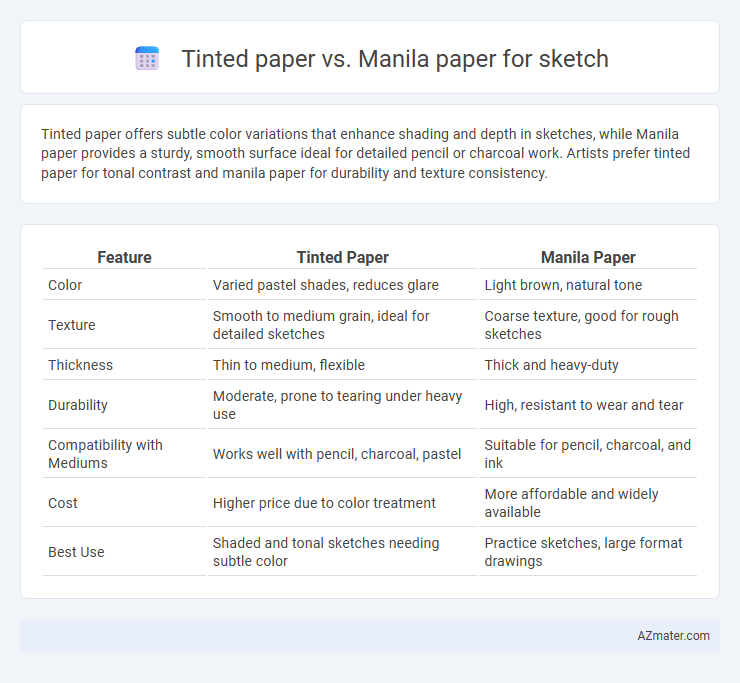Tinted paper offers subtle color variations that enhance shading and depth in sketches, while Manila paper provides a sturdy, smooth surface ideal for detailed pencil or charcoal work. Artists prefer tinted paper for tonal contrast and manila paper for durability and texture consistency.
Table of Comparison
| Feature | Tinted Paper | Manila Paper |
|---|---|---|
| Color | Varied pastel shades, reduces glare | Light brown, natural tone |
| Texture | Smooth to medium grain, ideal for detailed sketches | Coarse texture, good for rough sketches |
| Thickness | Thin to medium, flexible | Thick and heavy-duty |
| Durability | Moderate, prone to tearing under heavy use | High, resistant to wear and tear |
| Compatibility with Mediums | Works well with pencil, charcoal, pastel | Suitable for pencil, charcoal, and ink |
| Cost | Higher price due to color treatment | More affordable and widely available |
| Best Use | Shaded and tonal sketches needing subtle color | Practice sketches, large format drawings |
Understanding Tinted Paper and Manila Paper
Tinted paper features a subtle color tint, often in earth tones like beige or light gray, providing a mid-tone background that enhances contrast and depth in sketches. Manila paper, traditionally a light brown or buff color, is thicker and has a rougher texture, offering durability and a natural look ideal for charcoal, pencil, and pastel work. Choosing between tinted paper and Manila paper depends on the desired tonal range and texture for sketching, as tinted paper supports mid-tone highlights and shadows, while Manila paper emphasizes texture and robustness.
Composition and Texture Differences
Tinted paper offers a unique composition featuring a lightly colored, smooth surface that enhances tonal contrasts and highlights in sketches, making it ideal for graphite and charcoal work. Manila paper, known for its coarser texture and more fibrous composition, provides a rougher surface that grips pencil and ink, delivering a distinct tactile quality and variable line texture. These differences significantly influence the visual depth and detail in sketches, with tinted paper emphasizing subtle shading and manila paper supporting expressive, textured strokes.
Color Quality and Tone Effects
Tinted paper offers a richer and more nuanced base color that enhances sketches with natural depth and warmth, making highlights and shadows more pronounced without overpowering the drawing. Manila paper provides a neutral, light tan tone that creates a subtle vintage or classic effect, helping graphite and charcoal stand out while maintaining a flat color profile. Choice between tinted and Manila paper significantly impacts the tonal contrast and vibrancy, influencing the overall mood and quality of the sketch.
Ease of Use for Sketching Techniques
Tinted paper offers a smooth surface that enhances pencil and charcoal visibility, making shading and blending techniques more intuitive for artists seeking contrast and subtle tone variations. Manila paper provides a rougher texture that grips graphite and ink effectively, favoring detailed line work and expressive strokes while requiring less pressure control. Both papers support different sketching styles, with tinted paper enhancing tonal depth and manila paper promoting textured mark-making ease.
Surface Compatibility with Different Media
Tinted paper offers a smooth surface that enhances pencil, charcoal, and pastel application by providing subtle color contrast and minimal texture, making it ideal for detailed sketches. Manila paper features a rougher, fibrous texture that interacts well with charcoal, graphite, and ink, allowing for expressive line quality but may cause unevenness with fine-tipped pens or markers. Each paper's surface compatibility directly influences media performance and the final artwork's texture and tone.
Durability and Longevity
Tinted paper offers moderate durability with a surface that resists smudging and fading, making it suitable for sketches requiring subtle tonal variations. Manila paper, known for its sturdiness and thick fiber content, provides enhanced longevity and can withstand repeated erasing and layering without significant wear. Artists seeking durable sketching materials often prefer manila paper for its robust structure, while tinted paper excels in preserving the vibrancy of pencil or pastel sketches over time.
Cost Comparison
Tinted paper typically costs more than manila paper due to its specialized pigments and manufacturing process, making it a less budget-friendly option for extensive sketching projects. Manila paper is widely available and produced at lower costs, offering economical bulk purchasing benefits for artists focused on quantity. When comparing cost-efficiency, manila paper provides a more affordable surface for sketching without significantly compromising quality.
Suitability for Beginners vs. Professionals
Tinted paper offers subtle color tones that enhance shading and contrast, making it ideal for professional artists who require nuanced visual effects in sketches. Manila paper provides a neutral, affordable surface with moderate texture, suitable for beginners practicing fundamental drawing techniques. Professionals often prefer tinted paper for detailed work, while beginners benefit from Manila paper's simplicity and accessibility during skill development.
Environmental Impact and Sustainability
Tinted paper typically uses dyes and pigments that may involve synthetic chemicals, potentially increasing environmental impact compared to unbleached or recycled manila paper, which is often valued for its biodegradable and recyclable properties. Manila paper is usually made from natural fibers like abaca plants, promoting sustainability through renewable resources and lower chemical processing. Choosing manila paper for sketches supports eco-friendly art practices by reducing harmful waste and conserving natural ecosystems.
Final Recommendation: Choosing the Right Paper for Your Sketch
Tinted paper offers a subtle mid-tone background ideal for enhancing highlights and creating depth, making it perfect for artists who want to emphasize contrast and light effects in their sketches. Manila paper provides a sturdy, neutral-toned surface that is budget-friendly and versatile, suitable for both quick studies and more detailed work. For final recommendation, select tinted paper if your sketch benefits from tonal variations and dynamic shading, while manila paper is preferable for straightforward, cost-effective sketching with consistent texture.

Infographic: Tinted paper vs Manila paper for Sketch
 azmater.com
azmater.com